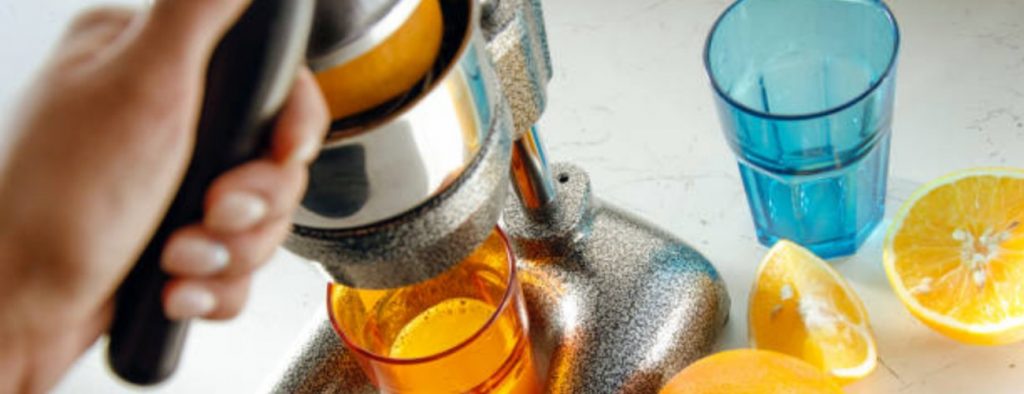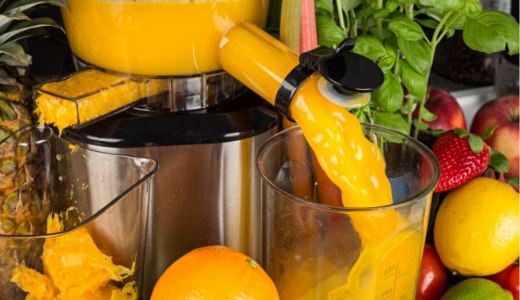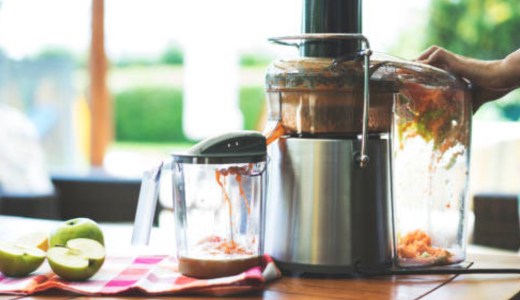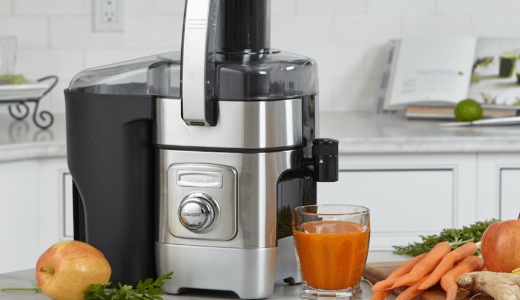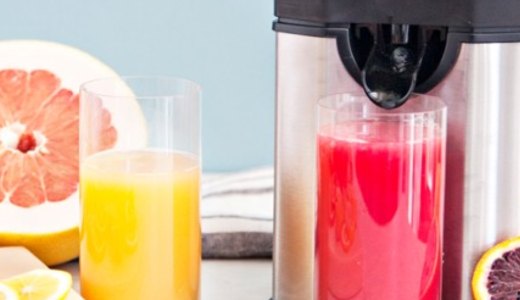When it comes to making fresh green or citrus juice at home, few other gadgets can compare to the efficiency and ease of use of a manual juicer. Those in the market for a new unit can even use this guide to identify the best manual or hand press juicer to meet their budget.
T here’s an old saying about making lemonade from lemons when life throws something bitter in your direction. But in a realistic situation, how are you supposed to prize a lemon’s tangy juice from its rind without the proper tools?
In a similar vein, how are you supposed to create nutrient-rich green juice in the comfort of your kitchen if your current appliances tear apart your leafy green produce?
These were the kinds of questions I was ruminating on until one of my good friends introduced me to the prospect of using a manual juicer or a hand press.
After letting me borrow their unit and trying it in my kitchen, I knew that there was no going back. I purchased my manual juicer and proceeded to simplify my daily green juice production process substantially.
While selecting the model that fit my qualifications for productivity and durability, I learned a lot about what you should look for in a high-quality manual juicer or hand press.
Today, I’m passing what I have learned onto you so that you can choose from between the nine best manual and hand press juicers on today’s market.
Contents
What is Manual Juicer?
At this point, you’re likely well-versed in what a “juicer” is, as far as primary uses are concerned. In essence, a juicer is an appliance or purpose-built gadget that simplifies the process of procuring juice from fresh fruits and vegetables.
Manual juicers are the most functionally essential iteration in this category. They rely on the user’s physical strength (as well as specialized components) to complete their core tasks.
Most often, manual juicers make use of a crank or lever to translate the user’s muscular strength into kinetic force.
Meanwhile, many “hand presses” operate through direct vertical pressure applied by the user onto the produce in question to create a friction that loosens the desired juice.
In either case, some degree of physical effort is required to operate these electricity-free units.
Their users value manual juicers and hand presses for a variety of reasons. First, manual units allow for much more flexibility when it comes to applying pressure.
You can expect a greater volume of dissolved nutrients to be preserved during the juicing process in turn.
Second, manual units are often lighter and more comfortable to transport, making them ideal for use in kitchens where storage space is at a premium.
At present, more and more routine at-home juice makers are turning to manual units to reach a juice quality standard. The faster and more expensive electric juicers cannot hope that to attain.
This may feel like a downgrade at first. But most manual juicer users will be quick to point out how much more efficiently manual juicers process leafy green produce (compared to electric centrifugal or masticating juicers).
Manual Juicer vs. Electric Juicer: What’s the Difference?
When most folks get into at-home juicing for the first time, they are often left to compare the market’s leading manual and electric machines all on their own.
However, such a process is like comparing apples to oranges (even though both would make a delicious juice cocktail).
Instead, you should compare the benefits and drawbacks of using each type of juicer before settling on the model that you’ll make a regular fixture in your home kitchen.
Manual Juicers
Pros
First and foremost, manual juicers are unbeatably affordable. In some cases, they cost as low as half the price of a comparable electric model.
Due to their lack of need for an electrical hookup, manual units can be transported just about anywhere you want to make flavorful, hand-squeezed produce juice.
Manual juicers are also entirely silent while in operation, a standard of operational quality that not even the slowest electric masticating juicers can attain.
Manual juicers also cannot be beaten when it comes to cleaning. They tend to make use of fewer components overall, thus abbreviating your cleanup process noticeably.
Cons
On the negative side, manual juicers suffer when it comes to efficiency. Because a manual juicer relies on physical inputs to operate, the unit’s overall efficiency tends to drop as the user becomes worn out.
Also, manual juicers tend to lack the strength needed to tear into dense produce, requiring precutting if the user ever hopes of processing their carrots and beats.
Electric Juicers
Pros
Electric juicers are prized primarily for their efficient operation that requires little to no physical exertion.
After inserting your desired produce, these electric units take care of the rest of the work through their centrifugal or masticating juicing mechanisms.
Some electric juicers can even work through a dense beat or carrot in a matter of seconds with their extra sharp dicing blades.
Electric juicers also tend to come with all of the components you need to begin juicing right out of the box.
This includes an appropriately sized juice collection container, as well as a pulp collection receptacle that attaches snugly to the main unit.
Some models even include dishwasher-safe internal components, allowing for a hassle-free cleanup process.
Cons
Electric juicers are naturally more expensive, per their increased capacity and efficiency. They also tend to be bulkier, both when placed on your kitchen counter and when stored away.
Their persistent need for an electric hook up also limits the number of locations that you can use an electric juicer unit.
Types of Manual Juicers
As with their electric-powered counterparts, manual juicers come in several distinct types that vary based upon factors such as their core architecture and operation method.
Each manual juicer type has its distinct advantages. Accordingly, prospective manual juicer users should carefully consider each type before settling on a particular model.
Handheld Manual Juicers
Sometimes referred to as a “citrus press,” this type of manual juicer makes use of two curved arms to extract juice through compression.
Some models even include a specialized tray that makes it easy to insert and remove pulp and rinds.
Typically, this type of manual juicer is used for spherical citrus fruits (though it can be adapted for use with other kinds of pre-cut produce).
Jug Reamers
Jug reamer manual juicers are made of two primary components: the juicing cone and a juice receptacle.
When combined, a user of a jug reamer can vertically apply pressure to their desire produce while rubbing it back and forth (cut side down) on the juicing cone.
Extracted juice then runs down the funnel and is conveniently collected in the attached cup. Many folks make use of jug reamers when making homemade orange juice.
Table-Top Hand Press
Table-top hand presses resemble a button maker, in terms of architecture, and operate through a similar pull-down compression system.
When a table-top hand press’ lever is pulled down, the unit draws down a heavy metal die that applies an even amount of pressure across the inserted produce.
This results in a greater juice yield per pull and requires less physical exertion on the user’s part.
Hand Crank Strainers
Hand crank strainers resemble hand crank meat processors, both visually and in terms of their core operations.
After mounting a hand crank strainer unit to a countertop, users put produce (particularly leafy greens) into the top-mounted chute.
Then, as the users operate the side-mounted crank, the produce is fed through the unit. This results in juice dripping out of a bottom-mounted chute. The pulp is extruded out of the far end.
Best Jug Reamer for Making Citrus Juice
OXO Good Grips 2-in-1 Citrus Juicer
What I Like About It: The OXO Good Grips is the prototypical modern jug reamer that can produce up to 1.5 cups of orange, lemon, or grapefruit juice without requiring excessive user exertion.
Key Features
- BPA-free plastics throughout
- Snap-on reamer
- 1.5 cup juice collector (with markings)
- Dishwasher safe
Pros
- Simplified clean up due to all plastic components being dishwasher-safe
- Reamer remains firmly in place through a snap-on system
- The curved body makes the unit easy to grip
Cons
- Some known complaints about #7 plastic used throughout body and reamer
OXO has long been known for providing simple solutions for manual juicing. The OXO Good Grips 2-in-1 Citrus Juicer represents another productive installment in that lineage, with a citrusy-twist.
To be more specific, this model allows for a more straightforward citrus juicing process due to its multi-prong cone reamer and curved plastic body.
The OXO Good Grips’ reamer won’t shift about while in use, either, thanks to its simple, yet innovative snap-in system.
Speaking of that body, you can expect it to hold up to the wear and tear of acidic citrus juices without degrading. That’s because this model uses BPA-free plastics throughout its construction.
As a bonus, every component of the OXO Good Grips is dishwasher safe, saving everyday juice makers a lot of time.
Hand Presses for Making Citrus and Pomegranate Juices
Gourmia GMJ9970 Large Citrus Juicer – Commercial Grade Pres
What I Like About It: The Gourmia GMJ9970 is a beautiful piece of American engineering that makes excellent use of both stainless steel construction and suction cup-style mounting feet.
Key Features
- Cast iron base and handle
- Stainless steel cup and crusher
- Tall, narrow architecture
- Suction cup mounting system
Pros
- Stainless steel cup is wide enough to produce up to the size of grapefruits
- Cast iron base and handle won’t degrade or rust over life of the unit
- Suction cups secure the unit without doing countertop damage
Cons
- Heavier than most manual juicers
Despite its weight, it will become immediately clear why the Gourmia GMJ9970 is so popular with at-home juice makers as soon as you pull down on its cast-iron handle.
This model is impressively resistant to damage from acidic juices, especially within its dishwasher safe stainless steel cup and crusher.
Also, the Gourmia GMJ9970 counterbalances for its weight by making use of a suction cup mounting system that does not damage countertops.
When stored upright, this model can even slot into the unused vertical space found in many kitchen cabinets.
Hamilton Beach 932 Commercial Citrus Juicer
What I Like About It: Though a commercial-grade unit, the Hamilton Beach 932 can provide just the right amount of functionality and longevity for any every day at-home juice maker.
Key Features
- Adjustable extraction pressure up to 2,000 lbs.
- Acid-resistance enamel coating across most surfaces
- Swing-out arm with 4 oz. cup
- 1-year warranty
Pros
- Can crush through even the densest produce, including beats and blood oranges
- Far exceeds 1-year warranty due to acid-resistant finish across exterior surfaces
- The swing-out arm can be useful for measuring juice volumes for recipes
Cons
- Expensive, by its commercial-grade classification
Don’t let its expensive price tag discourage you – the Hamilton Beach 932 is one of the most productive manual juicers on the market today.
This productivity starts in this model’s crushing arm, which can be adjusted to provide up to 2,000 lbs. of pressure.
That’s more than enough force to process any dense produce without extracting too much skin oil.
The Hamilton Beach 932 also has one of the most novel add-ons ever implemented into a manual juicer.
Specifically, this model’s swing-out arm includes a 4 oz. cup that is positively indispensable for home chefs who routinely use fresh juice in their recipes.
Overall, you can also expect this model to last for a decade or more without showing any corrosion, thanks to its acid-resistant enamel finish.
Best Manual Hand Crank Juicers for Leafy Greens, Wheatgrass, etc.
Handy Pantry HJ Hurricane Stainless Steel Manual Wheatgrass Juicer
What I Like About It: Though it looks pretty standard, the Handy Pantry HJ Hurricane goes beyond its calling to provide a crank that is easy to turn and an interior that is easy to clean.
Key Features
- All stainless steel construction
- The mounting clamp includes no-damage rubber foot cover
- Solid corkscrew auger
Pros
- Optimized for use with wheatgrass and other leafy green produce
- Corkscrew auger doesn’t lose its edge after several years of routine use
- Can mount on any 2.25” countertop
- Fairly lightweight
Cons
- Most non-leafy produce requires pre-cutting
On the surface, you might look over the Handy Pantry HJ Hurricane due to its general appearance.
But know such a choice will cause you to miss out on this model’s numerous quality features, including a solid corkscrew auger and micro-opening internal filter.
These two features combined make the Handy Pantry HJ Hurricane one of the best hand-cranked juicers for processing wheatgrass and other leafy green produce.
The Handy Pantry HJ Hurricane is also built from solid stainless steel throughout its architecture, which is a real surprise given its modest weight.
You’ll be able to mount this model onto most 2.25” kitchen counters without causing damage as well due to its three rubber mounting foot covers.
The Original Healthy Juicer (Lexen GP27) – Manual Juicer
What I Like About It: Though it may not be “the original” manual juicer, the Lexen GP27 certainly lives up to its high billing by way of its simplified suction cup mounting system and clear plastic body.
Key Features
- Easy-clean clear plastic body
- Large suction cup mounting system
- Stainless steel tipped auger
- Extremely lightweight and portable
Pros
- It can be easily transported due to easy release knob and 2.4 lbs. weight rating
- The clear plastic body is BPA-free and easy to clean
- Able to process kale, chard, collard greens, and more without trouble
Cons
- Plastic auger parts may degrade over time
For many at-home juice makers, the Lexen GP27 has become the standard when it comes to manual juicing. That’s because this model makes use of several innovative components.
They include a stainless steel auger tip – that allows it to process chard, kale, lettuce, collard greens, and more without clogging.
This is also one of the only manual juicers to make use of an entirely clear BPA-free plastic body that is easy to inspect while cleaning visually.
The Lexen GP27 is easily among the lightest in its class, weighing in at only around 2.4 lbs. As such, you’ll be able to release it from its large suction cup mounting with just a twist and travel with it to your next juicing location.
Happybuy Wheatgrass Extractor Portable, Manual Juicer with 3 Sieves
What I Like About It: Unlike other manual juicers that use this model’s body type, the Happybuy Wheatgrass Extractor excels above the industry standard. It prevents internal foaming and clogging that decrease the resulting juice’s nutrient content.
Key Features
- Ergonomic wood handle
- Stainless steel collection cup with handle
- Non-toxic stainless steel components throughout
- Available with 4-year protection plan options
Pros
- Wood handle prevents hand cramping during use
- Easy to disassemble and clean stainless steel components
- Efficiently processes barley grass, wheatgrass, lemongrass, and more
Cons
- More expensive than similarly equipped hand crank juicers
While the Happybuy Wheatgrass Extractor may not stand out on the store shelf, it will undoubtedly find a way to become one of your most-used kitchen gadgets.
That’s because its stainless steel components can make efficient work of wheatgrass, lemongrass, barley grass, and other leafy greens in their class.
Disassembly and cleanup afterward won’t take long at all with this model, either.
Many owners complement the Happybuy Wheatgrass Extractor for its use of an ergonomic wood handle that decreases the amount of stress exerted on the user’s hand.
Similarly, most are pleased to see that it can be purchased with a 4-year protection plan when obtained from certain online retailers.
Best Hand Crank Strainers for Making Tomato Juice
Roots & Branches VKP250 Johnny Apple Sauce Maker Model 250 Food Strainer
What I Like About It: The VKP250 has been uniquely engineered to process tomatoes, making it a must-have for at-home salsa and pasta sauce makers.
Key Features
- Secure ten sq. inch mounting clamp
- Cone-shaped tomato screen filter
- Extra-wide hopper
- Optional electric motor
Pros
- Can hold multiple tomatoes at once in the extra-wide plastic hopper
- Compatible with salsa, pumpkin, and berry screens
- Can be converted into an electric unit with optional motor
Cons
- Not as efficient when processing leafy greens
The VKP250 may at first feel like a black sheep in its class, due to its emphasis on manually juicing tomatoes. But in that particular category, the VKP250 is mostly unmatched.
Using this model’s durable pumpkin or berry screens, you’ll even be able to process two types of produce that other hand-cranked units struggle with.
Much to a strong user’s benefit, the VKP250 won’t shift about while in use. That’s because it makes use of a clamp mounting system that includes ten sq. inches of contact space.
Also, should you want to cut down on your physical exertion, the VKP250 can be converted into an electric unit using its manufacturer’s compatible motor.
Weston Food Strainer and Sauce Maker
What I Like About It: Even for its simple operational technique, this Weston food strainer is uniquely able to separate seeds and pulp from extra juicy produce.
Key Features
- 1-gallon hopper
- 4-piece screen and auger set
- Dual mount system with both clamp and suction cup base
Pros
- Each screen is made from stainless steel and around 1.5 mm thick
- Immediately drops juice out through wide slide
- Extra secure due to dual mounting system
Cons
- Smaller handle is harder to grip
This Weston manual juicer has made one significant improvement over all of its competitors – it uses two forms of mounting.
Between this model’s clamp and suction cup base, you can bet that it won’t move an inch while you crank through tomatoes and more.
Every bit of juice processed by this unit will effortlessly pour out as well, thanks in large part to its wide slide-like spout.
Each of these Weston manual juicer’s screens was built to last from 1.5 mm thick stainless steel, allowing them to be used repeatedly without bending or rusting. Even this model’s hopper is remarkable due to its girthy 1-gallon size.
Norpro 1991 Sauce Master II
What I Like About It: The Norpro 1991 is an affordable option in its subclass of manual juicers, making it a productive option for those who want to test the waters of at-home juicing on a budget.
Key Features
- High-walled hopper
- Easy-clean plastic components
- Extra-long refuse chute
Pros
- Produce pulp is deposited through an extra-long refuse chute
- Affordably priced for novice users
- Can be used to make applesauce, baby food, fruit leather, and more
Cons
- Minimal information on buying auxiliary screens
The Norpro 1991 may not be a gold medal winner in the manual juicer category. But it still serves a vital role as an affordably priced alternative for those new to at-home juicing.
Learning the ropes on this model is relatively easy, even if you decided to branch out and make nut butter, fruit leather, applesauce, or any other fresh-squeezed product.
Users who are fond of keeping their workspace tiding will also particularly enjoy the Norpro 1991 for its high-walled hopper and extra-long refuse chute.
Factors to Consider When Buying a Manual Juicer
What does the juice taste like? Making your homemade juice is primarily a matter of taste, making it imperative that you select a juicer model that filters out any undesirable contaminants.
Pulp tends to affect a juice’s flavor, which is why some modern juicers include built-in filters to make it easier to siphon off its resulting film.
How clean is the citrus rind? Many folks use their manual juicer to extract juice from lemons, limes, oranges, grapefruits, and other types of citrus.
Most people report the “cleanliness” of a rind after it has been fully processed in that juicer to evaluate a juice yield efficiency.
When paging through a manual juicer model’s reviews, be sure to identify whether or not its current users believe it able to clean a citrus fruit’s rind with precision.
How easy are the juicers to use? Though you will need to put in a bit of elbow work to make your manual juicer operate, you should still look for a model that is easy to use.
“Easy to use” can allude to many different qualitative measurements, though, including the difficulty associated with inserting produce, turning the unit’s cranks, or eliminating pulp from the unit’s spout.
User reviews are a great place to see these factors taken into consideration and analyzed against a recognizable “ease of use” standard.
How well is the juice strained? Along the same lines as a juice’s taste, you’ll want to be sure that your chosen juicer model can output a juicy product that requires little to no additional straining.
While such a step can be important for removing excess pulp and other contaminants, it can also be time-consuming during an already labor-intensive juicing process.
Look for built-in strainers and filters to qualify a given juicer’s ability in this domain.
Is it easy to clean? Juicing can be a messy business; there are no two ways about it. But after completing a full juicing session, you’ll be glad to have picked out a model that can be washed in a snap.
Ideally, an “easy to clean” juicer such disassemble easily and be able to be submerged in a regular sink full of soapy water.
If a model makes use of dishwasher-safe components, then it will be even easier to clean after your daily produce juicing session.
How much room does it take up? In terms of physical size, you should always quantify how much room a prospective juicer will take up if it is added to your kitchen.
This may include both spaces on a countertop or in a storage cabinet, depending on how regularly you intend to use your juicer.
What’s your budget? As with all kitchen appliances and gadgets, you should only choose a juicer model that fits within your present purchasing budget.
Ideally, you should identify and purchase the most cost-effective units that provide you with the most features and high-end specifications without pushing a premium price tag.
Purchasing your juicer from a qualified online retailer or directly from the manufacturer can also make specific models more affordable.
Health Benefits of Freshly-Squeezed Juice
Freshly-squeezed juice comes with numerous health benefits, many of which are well-attuned to the wellness goals of physical fitness-minded individuals.
Most notably, fresh-squeezed juices are an efficient method for ingesting most of the nutrients housed inside a particular type of produce.
Also, fresh-squeezed juices lack the sugar and preservatives found in store-bought juices.
To learn more about fresh-squeezed juice’s many valuable health benefits, you can read more from the Food Network and Livestrong.
What fruits are good for manual juicing?
As you might expect from their architecture, almost all manual juicers can process citrus fruits without complaint.
Indeed, many manual juicers are most efficient when used on an open-face, spherical fruit of any kind.
That means that pomegranates are fair game in most manual juicers, as are tomatoes if you so desire.
Most berries can also be used in a manual juicer, though they require slightly more care when placing them under the right amount of pressure.
What vegetables are good for manual juicing?
Above all else, manual juicers are great at handling leafy green vegetables of all types. That means that you are a-go for processing kale, spinach, lettuce, and more if you have a manual juicer in your kitchen.
Beyond this, though, manual juicers can process common vegetables such as celery and carrots, so long as they are cut down to a manageable size before insertion.
Frequently Asked Questions
Do you have to drink the juice immediately after juicing?
Most folks recommend storing homemade juice for between 48 and 72 hours, depending on the type of container used and the number of times that container is opened in the intervening time.
During that time, juice’s taste and nutritional content tend to degrade, making it best to drink within an hour of its production.
Is juicing the best way to lose weight?
A proper diet and exercise are the best ways to lose weight, generally speaking. However, your doctor can make more accurate recommendations based on your health history and body type.
Drinking homemade juice alone – regardless of the nutrients contained in the juice – cannot cause you to lose weight, though.
Can I drink green juice every day?
Indeed, you can drink green juice made from leafy green vegetables every day. You wouldn’t be alone if you chose to do so.
Many fitness-oriented individuals enjoy a small glass of green juice each morning and evening, following a hard workout. Regularly drinking green juice can also help improve your digestion, leading to more regularity.
Do you add water when juicing?
As far as during the juicing process is concerned, you should not add water while your juicer is in motion.
However, you may choose to add water to your raw juice to dilute it slightly. This can be especially useful when you are trying to make bitter green juice more palatable.
Is blending better than juicing?
When it comes to creating flavorful and nutritious juice from fresh produce, juicers are by far the best tool for the job. Juicers are purpose-built, after all, and are often able to separate a piece of produces pulp from its juice more efficiently.
Blenders scramble all of that plant matter together, leading to a thicker (though less nutritional) juice yield.
Conclusion: What Manual Juicer is Right for You?
Overall, there’s a lot you need to know and consider if you are looking to find the best manual juicer for your at-home juicing needs.
While many juicers excel at processing leafy greens and citrus fruits, only a few manual juicers can be counted on to provide the durability and ease of use necessary to make the at-home juicing process a daily activity worth looking forward to.
Now, as you go out into the manual juicer marketplace, be sure to use what you learned in this guide to inform your purchasing decisions.
Once you’ve found the model that fits your juicing needs and your budget, you’ll be just a quick purchase away from making juice like it a part of your daily wellness routine.

